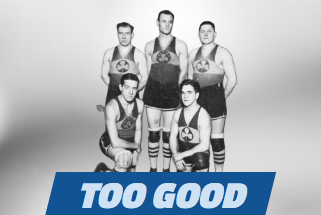The Original Celtics basketball team had nothing to do with Boston and was so good, that they had to be disbanded by the league they played in.
But before this happened, embezzlement, innovation, and dominance were all part of their story.
The Chicken-Wire Days
Professional basketball first started up in the United States before the turn of the last century, when the National Basketball League (NBL) formed in 1898.
Back in those early days, instead of a sideline, a chicken-wire cage surrounded the court.

Players were affectionately known as “cagers”, often clashed with hostile fans (hence the cage), and there were no out-of-bounds or traveling rules. Wild times.
Not long after this, the best team of this era, the Original Celtics, were born in New York.
From New York Teens to Invincible
The first incarnation of the team was the New York Celtics, formed by a shadowy figure named Frank McCormack in 1914.
Frank basically herded together a group of Hell’s Kitchen teens like stray cats and paid each a modest amount to play in semi-professional exhibition games.
Word quickly spread that you could get paid to play ball if you had handles and some hops, and the team gradually began adding better and better players.
It took a world war and a national army service draft to put a stop to this team’s run.
Get up to 20% off the new Christmas range at the NBA Store, including some really ugly Christmas jumpers.
The second iteration, ironically known as the “Original Celtics,” was assembled by boxing promoter James Furey in 1918, and they took things to a whole other level.
Guys with names like the “Babe Ruth of Basketball” John Beckman, George “Horse” Haggerty, John “Pete” Barry (no one knows exactly why they called him Pete), and future Naismith Hall of Famer Joe Lapchick made the Original Celtics so good, that they won 193 out of the 205 games they played in during 1922-23.
A better winning percentage than the 1995-96 Bulls’ .878.
The dominance didn’t stop there.
Break up the Celtics!
During the early days of the upstart American Basketball League (ABL), which was the first national pro basketball league in the U.S., league management was desperate for a draw to bring people in the door, and the Original Celtics fit the bill.
ABL President Joe Carr made sure he got his way by prohibiting any ABL team from playing in exhibition games against the Celtics, dwindling their earning potential on the barnstorming circuit.
There was also one more catch.
The team would have to inherit the 0-5 start of the Brooklyn Arcadians, who dropped out of the league.
Celtics owner Jim Furey reluctantly agreed to join the ABL, starting a love/hate relationship with the league.
What happened next was a form of sweet revenge.

The Original C’s proceeded to dominate the league like an elementary school bully, pushing around other teams en route to a 40-9 record in 1927-28 and the next two ABL titles.
During an era where skills were in short supply, the game was rough, and the standard fine for “aggravated offenses” was $25, the Original Celtics, with their fast-paced play and teamwork, were the most consistently successful team.
Following their second straight title win, the league had enough and decided to do what fans of other teams had long been clamoring for – break up the Celtics.
Corporate heel Joe Carr dispersed Celtics players to other teams and pressured Madison Square Garden management, where the team played, to terminate its lease with Jim Furey, who by this time was dealing with his own set of problems.
Embezzlement & Prison
One historian, who wrote an entire book documenting the rise of the Original Celtics, says the real reason the team agreed to join the ABL was an entirely different one.
Apparently, Jim Furey had been keeping a dark secret.
Besides owning the Celtics with his brother Tom Furey, Jim was also the manager of the Arnold Constable & Company department store in New York. At one time, a Fifth Avenue fixture.
He was accused of using his position at Arnold Constable to embezzle nearly $200K from the store, which he presumably used to fund his basketball venture and perhaps also an alcohol addiction.
Thus, joining the ABL before his three-year prison stint at Sing Sing meant his team was less likely to fold, given the implicit backing of the league.
For a time, he was proven right. Despite the lack of management, the Celtics soldiered on, and if it wasn’t for the team abusing other squads, perhaps the league may not have disbanded its reigning champion.
In the end, the ABL’s move backfired as game attendance plummeted and the ensuing Great Depression ended the league itself.
As for the Celtics, Jim Furey attempted to revive the team one last time upon his release from prison, but it was a shell of its former self due to aging players and a lack of financial support. It was never able to recapture the success it experienced throughout the 1920s.
A team from Boston that would adopt its namesake would go on to fare much better.
If you enjoyed this article, you may also like The Toronto Raptors’ Expansion Team Was Wild or The Team that has gone to every Final in Lithuanian Basketball League History

Leave a Reply